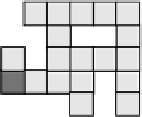Biomedical Engineering Reference
In-Depth Information
Source
Defect
Sink
Figure 6.13
Example of a defect that cannot be precisely localized by the column and row test.
The final step, that is, the row test, can be carried out in the same way as
the column test.
As discussed in Chapter 4, Subsection 4.1.1, the test outcome is read out
using a capacitive sensing circuit located at the sink reservoir. Different fault
patterns are mapped to different pulse sequences observed at the capaci-
tive sensing circuit. However, note that, here, defects in the multiwell design
cannot be precisely localized by carrying out the column and row tests
together. This is because, in the multiwell chip design, not all the columns
and rows are used as transportation pathways. There are many electrodes
on the transportation pathway that are not at the intersections of any used
column and rows, as shown in Figure 6.13.
In the case shown in Figure 6.13, the sensor readout indicates an error for
only one step, that is, the column-test. As a result, we can only determine
which column the defect resides on, based on the column and row test
outcome. To achieve precise defect localization, a binary-search method can
be used, which iteratively partitions the defective column and carries out a
single line test, as shown in Figure 6.14.
6.1.4 Defect Tolerance
The design presented in Subsections 6.1.1 and 6.1.2 may suffer from fabrication
defects or operational faults. In this section, we introduce a “cross-loading”-
based method to achieve defect tolerance for the proposed chip design. We
rely on the use of the testing and diagnosis methods in Chapter 4 to locate
defect sites.
We first classify defects into three categories based on their locations on the
chip. Note that, in the well-loading algorithm proposed in Subsection 6.1.2,
wells are loaded from one side, that is, the right side or left side. Therefore,
not all the electrodes are used. If a defect occurs in these unused electrodes,
then it will not affect droplet manipulations on the chip. We refer to this
type of defect as a
benign defect
. In the design described in Subsection 6.1.1,
























